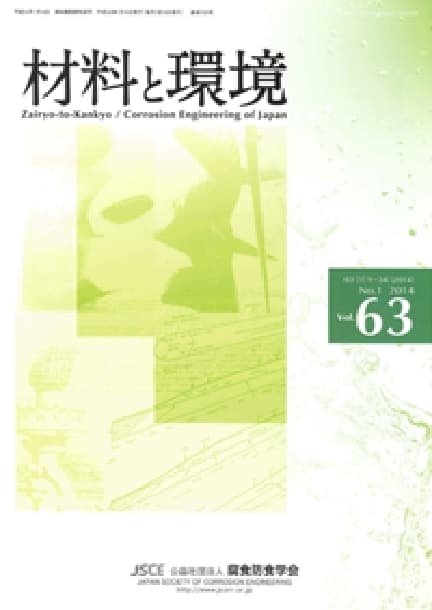- TOP
- Zairyo-to-Kankyo
- Vol. 62 (2013), No. 8
Zairyo-to-Kankyo Vol. 62 (2013), No. 8
Backnumber
-
Vol. 74 (2025)
-
Vol. 73 (2024)
-
Vol. 72 (2023)
-
Vol. 71 (2022)
-
Vol. 70 (2021)
-
Vol. 69 (2020)
-
Vol. 68 (2019)
-
Vol. 67 (2018)
-
Vol. 66 (2017)
-
Vol. 65 (2016)
-
Vol. 64 (2015)
-
Vol. 63 (2014)
-
Vol. 62 (2013)
-
Vol. 61 (2012)
-
Vol. 60 (2011)
-
Vol. 59 (2010)
-
Vol. 58 (2009)
-
Vol. 57 (2008)
-
Vol. 56 (2007)
-
Vol. 55 (2006)
-
Vol. 54 (2005)
-
Vol. 53 (2004)
-
Vol. 52 (2003)
-
Vol. 51 (2002)
-
Vol. 50 (2001)
-
Vol. 49 (2000)
-
Vol. 48 (1999)
-
Vol. 47 (1998)
-
Vol. 46 (1997)
-
Vol. 45 (1996)
-
Vol. 44 (1995)
-
Vol. 43 (1994)
-
Vol. 42 (1993)
-
Vol. 41 (1992)
-
Vol. 40 (1991)
Keyword Ranking
28 Oct. (Last 30 Days)
Zairyo-to-Kankyo Vol. 62 (2013), No. 8
Influences of Mixing and Porosity Ratios of Porous Sintered Al-Zn Plate and Material Property of Fiber Sheet on Anticorrosive Effects of Sacrificial Anode for Carbon Steel in Atmospheric Environment
Shigenobu Kainuma, Kazuhiro Utsunomiya, Shuji Ishihara, Daisuke Uchida, Akira Kaneko, Takao Yamauchi
pp. 278-288
DOI:
10.3323/jcorr.62.278Abstract
In authorsʼ previous research, an anticorrosive method with sacrificial anode for steel members in atmospheric environment was proposed. In this method, porous sintered Al-Zn plate was applied as sacrificial anode materials. In addition to this, chemical fiber sheet was applied as the material which has functions of continual water absorption and retention needed for sacrificial anode reaction.
The object of this research is to clarify the influences of mixing and porosity ratios of the sintered plate and property of the fiber sheet on the anticorrosive effects and to investigate applicability of the anticorrosive method in various atmospheric environments. Electro-chemical tests using the sintered plate and material property tests using the fiber sheet were carried out. Moreover, atmospheric exposure tests were also conducted on the model specimens composed of the steel plate, the fiber sheet and the sintered plate. The results showed that the anticorrosive method seems to be applicable in atmospheric environments by controlling the anticorrosive effect and consumption of anode materials by putting various kinds of the sintered plate and the fiber sheet together.
Corrosion Behavior of Prestressing Steel in a Solution of 20% Ammonium Thiocyanate
Mikiyuki Ichiba, Yuya Niidome, Shunsuke Nakamura, Junʼichi Sakai
pp. 289-293
DOI:
10.3323/jcorr.62.289Abstract
High-strength steels or PC steel products are used for pre-stressed concrete structures. Testing of PC steel products in terms of hydrogen embrittlement is specified in the FIP Report, and the test method adopted in ISO 15630 is well known. This test is called the FIP test, whereby a constant load is applied to PC steel in a 20%, 50℃ ammonium thiocyanate solution. An investigation was carried out on the corrosion behavior of 1,400 MPa class PC steel products in a FIP testing environment. Under this testing environment, a cathodic reaction associated with oxygen consumption and hydrogen generation was identified from the initial stage of dipping, and corrosive products mainly consisting of ferric sulfide were formed on the surface of a specimen detected in the test pieces. From changes in the amount of gas associated with the reaction, it is understood that, together with this corrosion reaction, there also occurred a reaction involving 1 mol of hydrogen generation or 0.5 mol of oxygen consumption for 1 mol dissolution of iron. It is also assumed that the reaction involving hydrogen generation was a cathodic reaction associated with the decomposition of SCN-.
Article Access Ranking
28 Oct. (Last 30 Days)
-
Perspectives on the Promising Pathways to Zero Carbon Emissions in the Steel Industry toward 2050
ISIJ International Vol.65(2025), No.2
-
Integrated Steelworks that Reduce CO2 Emissions by More Than 80% ─ Challenge for Carbon-Neutral Integrated Steelworks ─
Tetsu-to-Hagané Vol.111(2025), No.13
-
Growth, Removal, and Agglomeration of Various Type of Oxide Inclusions in Molten Steel
Tetsu-to-Hagané Vol.111(2025), No.11
-
Advanced Coil Cooling Model Incorporating Layering and Interface Effects of Strip Windings
ISIJ International Vol.65(2025), No.11
-
Thermodynamic Evaluation of Interaction Parameters of Solutes in Molten Iron
Tetsu-to-Hagané Vol.111(2025), No.14
-
Capillary Infiltration of Slag in Hydrogen-Direct Reduced Iron and Influence on Melting
ISIJ International Vol.65(2025), No.11
-
A new simulation characterization method to reveal the causes of cracking for cast iron cooling staves
ISIJ International Advance Publication
-
Research Progress on Optimal Blending of Iron Ore Powders for Sintering
ISIJ International Advance Publication
-
Influence of Tensile Stress during Annealing on Primary Recrystallization Texture Development in Fe-3%Si Alloy
ISIJ International Vol.65(2025), No.11
-
Cellular automaton model for quantitative prediction of microsegregation in alloys
ISIJ International Advance Publication
You can use this feature after you logged into the site.
Please click the button below.










